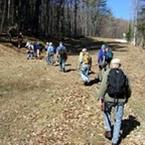 “New Hampshire residential home sales experienced the largest single-month increase on record last month (November) as sales jumped 70% from November of 2008.” In 2008, November saw 673 sales; in 2009, there were 1,141. The NHAR (New Hampshire Association of Realtors which tracks real estate data for the State) attributed the jump in part to the home buyer tax credit incentive. The jump was also considered a signal that the NH real estate market is in the middle of the early stages of recovery which will head us back to a “normalized residential housing market”. The cumulative totals for 2009 are about 5% ahead of the same period last year. Also important about the increase in the number of sales is that it has helped to drive down the statewide inventory to a 9.1 month supply. For comparison, at the end of January, 2009, it was at a 22 month supply. Prices do continue to lag, however, which should continue to make buying a home very attractive to buyers. The median price of last November was at $215,000 and dropped 2.8% this November to $209,000. Source: NH Union Leader 12/16/2009
“New Hampshire residential home sales experienced the largest single-month increase on record last month (November) as sales jumped 70% from November of 2008.” In 2008, November saw 673 sales; in 2009, there were 1,141. The NHAR (New Hampshire Association of Realtors which tracks real estate data for the State) attributed the jump in part to the home buyer tax credit incentive. The jump was also considered a signal that the NH real estate market is in the middle of the early stages of recovery which will head us back to a “normalized residential housing market”. The cumulative totals for 2009 are about 5% ahead of the same period last year. Also important about the increase in the number of sales is that it has helped to drive down the statewide inventory to a 9.1 month supply. For comparison, at the end of January, 2009, it was at a 22 month supply. Prices do continue to lag, however, which should continue to make buying a home very attractive to buyers. The median price of last November was at $215,000 and dropped 2.8% this November to $209,000. Source: NH Union Leader 12/16/2009
Some of the best hiking trails in our area are minded by a very dedicated group of volunteers. These trails cover 75 miles surrounding Lake Sunapee and going over Sunapee, Ragged and Kearsarge mountains.
The Sunapee-Ragged-Kearsarge Greenway Coalition was formed in the mid-eighties by, as their brochure says, “a group of creative environmentalists” who were associated with the Ausbon Sargent Land Preservation Trust, the Society for the Protection of NH Forests, the Lake Sunapee Protective Association and local conservationists. That early group has evolved into a non-profit corporation led by directors from those towns which have SRKGC trails in them: Andover, Danbury, Goshen, Newbury, New London, Springfield, Sunapee, Sutton, Warner & Wilmot. The brochure best states their mission: “…to create and maintain a forever-green great circle of trail corridors and protected lands providing walkers with access to the mountains, lakes, vistas and historical sites of the region.”
The SRKGC is a wonderful example of the cooperation of enthusiastic volunteers, private landowners, and state and local governments. The organization welcomes new volunteers and memberships. Visit their site at: http://www.srkg.com/ There you will find a wealth of information on other hiking resources, as well as additional information about the trail network itself.
Ultimately, the market dictates value, based on current conditions. Your house has many values-one to the tax assessor, others to your lender and insurance company, and yet another value to you, the owner. Prospective buyers will also value it differently. What a buyer will pay is typically called "market value". The best price obtainable in any market can only be determined by aggressively testing the market and challenging the competition. So...what affects the value of your house? There are some factors which have no effect on the current value of your property, and you probably know what they are: what you paid for your house; the cash proceeds you want or need from the sale; or what your friends and neighbors say your property is worth. Also, there are some factors that are "given" - over which we have no control: your property's location, age, the size of the house and lot, and its floor plan and architectural style. Also, we cannot control the market conditions, including interest rate and the availability of financing, buyer demand, the state of the economy, the prices of recently sold properties, or the possible seasonality of demand. We also have no control over the competition: how many similar properties are for sale, or their prices, financing terms, location and physical condition. But, we can control the asking price!
Here’s your winter checklist! You look outside one day and it's bright and sunny and the next day snow begins to cover the leaves you forgot to rake. That's right, winter is just around the corner and you need to get your home ready. Also check wood floors just inside patio and exit doors for signs of water entry. Probe through the carpet or check under the doors from the basement or crawl space area for signs of dampness. Look for rotting sub-flooring, floor joists and sill plates (the wood that rests on the foundation wall). If possible, check behind the insulation for signs of rotting or infestation. Vinyl floor covering can be discolored from mildew trapped between the vinyl and wet sub-flooring. Caulk and seal around window and door openings. Fill cracks and openings in concrete drives, walks and patios. Have the heating system and flue inspected by a qualified heating technician. It is very important to change or clean the furnace filter on a regular basis. If the furnace has a built-in humidifier, have the humidifier cleaned. Treat the humidifier each month during the heating season to resist mold growth inside the air system. Have the chimney cleaned and inspected by a certified chimney sweep. Store fire wood two to three feet off the ground and away from the home's foundation. Wood piles invite unwanted guests all year long. Garden hoses should be drained and stored inside. If you have shut-offs for the outside hose faucets, they need to be closed for winter. Do not leave a garden hose connected to an outside faucet. Even an anti-freeze faucet will freeze and eventually leak if a hose is left connected all winter. Drain the gasoline from lawn mowers, weed eaters, etc. Remove grass, dirt and all debris and store for winter. Stuff a paper towel in the gas tank, leaving enough of the towel exposed so the towel can later be removed. Store the equipment with the gas lid off. The tank has to be drained with no gasoline or gasoline fumes present before the paper towel is stuffed inside. The towel keeps the inside of the tank dry and ready for next spring. Never store gasoline or equipment containing gasoline inside the home, garage or basement.
From a prospective homebuyer’s view, clutter translates into an undesirable home. Cluttered homes often appear smaller. They look darker, and tend to smell from the excess dust. Too much “stuff” around can be an immediate turn-off because the combined effect suggests that all of the home’s other features will be rundown, decayed and in need of much repair. The opposite is also true: homes devoid of clutter and kept clean give the impression of being well maintained and not requiring much work. Clutter compromises the ideal image and prospective buyers view the home in terms of cleaning and maintenance. 1Y0-A05 Properties with clutter translate into increased time on the market and lower values, not only because the clutter decreases the perception of size, air and light, but also because it makes buyers think that there will be a lot of work involved in maintaining the property. If you need help to de-clutter, call a professional. This initial cost will be recouped with a higher selling price and faster sale. For more helpful hints, go to: http://www.realtor.com/Basics/Sell/PrepHome/GetReady.asp
The Kearsarge Regional School District includes the towns of Bradford, Newbury, New London, Springfield, Sutton, Warner and Wilmot. As of 10/1/09, the enrollment from these towns totals 2,135 students. There are separate elementary schools (K-5) in Bradford, New London, Sutton and Warner. Springfield also has its own Kindergarten program. In March of 2007, the district opened a new and beautiful 123,321 square foot middle school in North Sutton. The old middle school in New London had become functionally obsolete, and 80 acres were purchased to include future growth. If you have not taken a drive around the new school and its well manicured playing fields, you really should do so! There are three grades there- 6,7, and 8. Each cluster has its own classrooms and common area. Stop in and take the tour of the impressive gym, cafeteria and library. Other spacious rooms house international languages, band, chorus, music, tech. ed and family and consumer science. There are about 460 happy students attending this school! Kearsarge Regional High School, also in North Sutton has a freshman academy wing that allows the freshmen to acclimate themselves to the school before blending in with the upper classmen. There are many wonderful activities going on there on a daily basis. One huge asset at this school is Project Climb. Hiking, canoeing and bike trips are enjoyed tremendously by members of this group. The High School Chorus goes to Disney World each Spring Break and performs on stage. They have won many awards! Their sports teams participate at the Class I Level for athletics. The school district has a website (Kearsarge.org) that is easy to access, should you need any further information.

Congress has changed the rules – effective as of 2009 – for vacation homes and rental properties. Here’s what you need to know about paying the piper. 1Y0-309 Congress has pulled the rug out from under vacation and rental home owners planning to squeeze tax-free profit from their second homes. Under current law, you could sell your primary residence and take up to $250,000 of profit - $500,000 if you file a joint return – tax-free, as long as you owned and lived in the place for two of the five years leading up to the sale. Then you could move into your vacation home or a rental property and, by living in it for at least two years, get a second bite of the tax-free apple. Even profit that built up while it was a vacation home or rental could dodge the IRS. No more. To help pay for the big housing bill passed this summer, Congress has changed the rules so that some of your gain will be taxable of you convert your vacation home or rental unit to a primary residence after 2008. The portion of the gain to be taxed is based on the ratio of non-qualified use – the time the property is used as a vacation home or rental unit after this year – to the total amount of time you owned the property. Assume you bought a second home in 2000. Let’s say you convert it to your primary residence in 2011 and sell it two years later. In this example, the home would be used as a vacation property for two years after 2008, so one-seventh of the profit (two out of the 14 years you owned it) would be taxed at capital gains rates. The remainder of the gain – up to $500,000 for couples – would be tax-free. This tax law change could be even more significant if you buy a second home after 2008. In that case, none of the time it is used for vacations or rental income qualifies for the tax exclusion. But if you convert it to your principal residence, the longer you live there, the less the profit from a sale will be taxed. And you can avoid the crackdown altogether if you move in before the end of this year, says Raffaele Mari, a CPA in Corona Del Mar, CA. But what do you do with your current home? You could rent it to general case flow and buy some time before selling it in this slow housing market, Mari says. The tightening doesn’t apply in reverse: You’d still qualify for tax-free profit on the home as long as you sell it within three years to meet the two-of-five-years test. 1Y0-731 Source: Mary Beth Franklin, Kiplinger’s Personal Finance, Kiplinger.com
Here's how to do it right wherever you live, plus what all the numbers on containers mean Fact: Recycling one aluminum can saves enough energy to run a TV for three hours. So, yes, it pays off. Here’s how to do it right wherever you live. Collect newspapers in a paper grocery bag or in tied bundles, depending on your community’s guidelines, and set them out on pickup day. (It takes up to 75,000 trees to produce one Sunday edition of the New York Times.) Don’t recycle wet cardboard. It can clog sorting machines. Throw it away to keep it from contaminating the rest of the load. Don’t recycle bottle tops; they’re not made from the same plastic as recyclable bottles. But if you forget, don’t sweat it. They’ll be sorted down the line. (The energy saved by recycling one plastic bottle can power a computer for 25 minutes.) Rinse cans, but crushing isn’t necessary. The aluminum can is the most recycled item in the United States, as well as the most valuable. It can be recycled again and again, and so efficiently that a can is regenerated and back on the shelf in as little as 60 days. Don’t fret if you can’t get the lime out of the beer bottle or the last of the peanut butter from the jar. The recycler’s machinery will zap all contaminants. But do empty and rinse glass jars and containers. Wondering about the little numbers on your milk container? They identify what the container is made of — and what it will be in its next life. 1 PET (polyethylene terephthalate): Soda bottles; recycled into pillow fill. 2 HDPE (high-density polyethylene): Plastic milk bottles, detergent bottles; recycled into new detergent bottles. 3 PVC (polyvinyl chloride): Take-out boxes, shampoo; recycled into drainage and irrigation pipes. 4 LDPE (low-density polyethylene): Grocery bags, shrink wrap; recycled into new bags. 5 PP (polypropylene): Yogurt containers, bottle caps; recycled into plastic lumber. 6 PS (polystyrene): Packing peanuts; recycled into plastic lumber, cassette-tape boxes. 7 Other: Includes squeezable ketchup bottles and microwavable dishes; these items can’t be recycled. Reproduced from www.realsimple.com
In the New London/Lake Sunapee area real estate market, or any market for that matter, overpricing a home in a buyer’s market is definitely not a good strategy for selling. Today’s buyers are very cautious about overpaying, are more discerning and are less likely to accept defects found on inspections. With the abundance of properties on the market and price reductions seen on a daily basis, buyers are taking longer to buy and are pickier about what they buy. Sellers should not aggressively price their house in anticipation of buyers making offers. Most buyers won’t waste their time offering on a listing over-priced for the market – especially when there are other choices. In fact, other agents will use your over-priced listing to help them sell the well-priced listings. In this changing market, sellers are no longer in the driver’s seat. Comparable sales from even a few months ago may not be applicable for today’s market. For best results, rely on your realtor for a realistic price assessment. [caption id="attachment_52" align="aligncenter" width="117" caption="Donna Forest, ABR"]
 [/caption]
[/caption]


